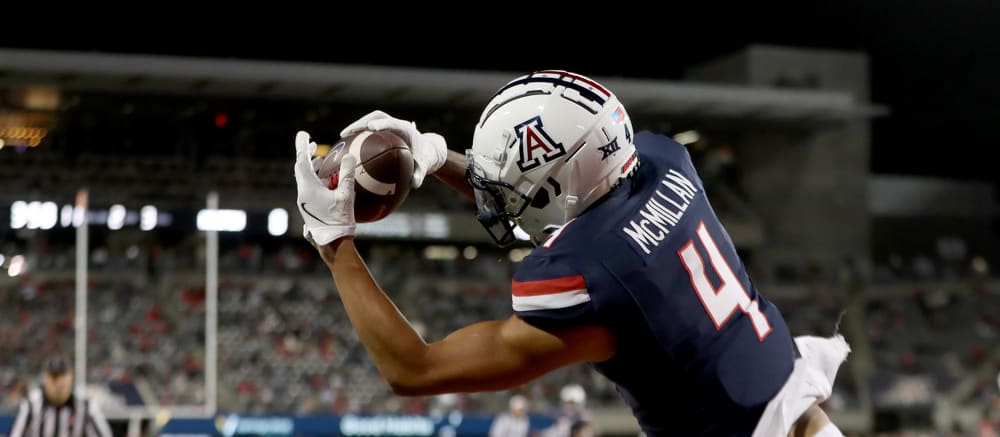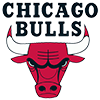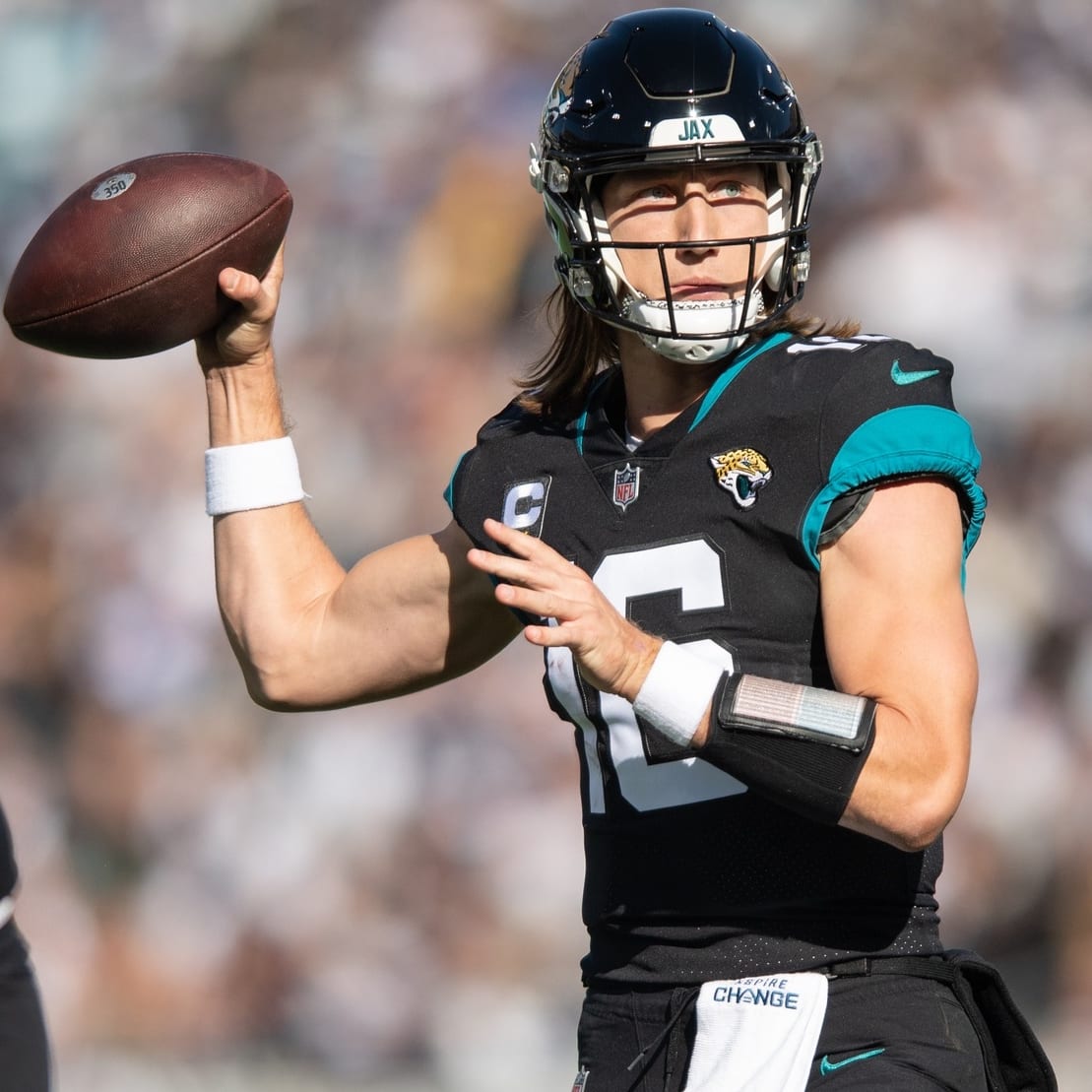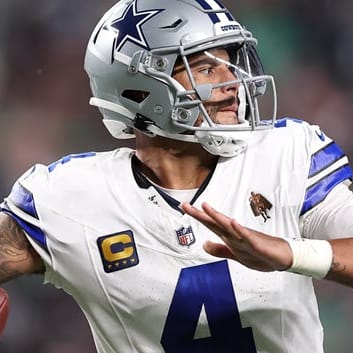NFL Combine: Rookie Rankings for Best Ball
Since the explosion in popularity of dynasty leagues, understanding the rookie class has taken on increased importance. That has only grown since the boom in the popularity of best ball and specifically pre-draft contests such as the Little Board and Big Board on Underdog.
This year, those contests opened in the middle of the NFL playoffs and will close before the start of the NFL Draft, meaning selecting rookies has the potential for big rewards but also requires taking on significant risk. As we enter the week of the combine, now is a good time to consider where rookies stand in Underdog ADP and the relative values of players based on their projected draft capital and college production profile.
For now, we'll review each skill position with a chart that includes a player's ADP, positional ADP and projected draft capital while highlighting some of the best values and players to avoid. We'll re-assess next week after Combine results are in, evaluating some additional risers and fallers.
Rookie Quarterbacks
| Name | College | Overall ADP | Positional ADP | Projected Draft Capital |
| Cam Ward | Miami | 153.1 | QB24 | Top 10 |
| Shedeur Sanders | Colorado | 175.1 | QB28 | Top 10 |
| Jaxson Dart | Ole Miss | 208 | QB31 | Early Round 2 |
| Jalen Milroe | Alabama | 237 | QB35 | Round 2 |
| Tyler Shough | Louisville | 239.8 | QB41 | Day 2 |
This isn't a good quarterback class and there aren't likely to be any major fantasy contributors similar to what we saw from Jayden Daniels and the rest of
NFL Combine: Rookie Rankings for Best Ball
Since the explosion in popularity of dynasty leagues, understanding the rookie class has taken on increased importance. That has only grown since the boom in the popularity of best ball and specifically pre-draft contests such as the Little Board and Big Board on Underdog.
This year, those contests opened in the middle of the NFL playoffs and will close before the start of the NFL Draft, meaning selecting rookies has the potential for big rewards but also requires taking on significant risk. As we enter the week of the combine, now is a good time to consider where rookies stand in Underdog ADP and the relative values of players based on their projected draft capital and college production profile.
For now, we'll review each skill position with a chart that includes a player's ADP, positional ADP and projected draft capital while highlighting some of the best values and players to avoid. We'll re-assess next week after Combine results are in, evaluating some additional risers and fallers.
Rookie Quarterbacks
| Name | College | Overall ADP | Positional ADP | Projected Draft Capital |
| Cam Ward | Miami | 153.1 | QB24 | Top 10 |
| Shedeur Sanders | Colorado | 175.1 | QB28 | Top 10 |
| Jaxson Dart | Ole Miss | 208 | QB31 | Early Round 2 |
| Jalen Milroe | Alabama | 237 | QB35 | Round 2 |
| Tyler Shough | Louisville | 239.8 | QB41 | Day 2 |
This isn't a good quarterback class and there aren't likely to be any major fantasy contributors similar to what we saw from Jayden Daniels and the rest of the 2024 class. Ward should be selected inside the top five with the chance to start immediately, and he could reasonably outperform his current ADP. While he is a playmaker, he hasn't displayed the rushing ability or desire of a player like Daniels or even Drake Maye.
Sanders is a pocket passer so his fantasy ceiling isn't likely to be very high in his rookie season. His ADP is more palatable, however, as one of the last likely starters off the board with the exception of Matthew Stafford.
Dart has been the trendy rising quarterback we often see during draft season, but there's no reason to risk drafting him at this point given all the surefire options at the position. If he regularly starts being mocked in the first round, he is a player potentially worth revisiting.
Journeyman Tyler Shough has also been generating some buzz going into Combine week.
Running Back
| Name | College | Overall ADP | Positional ADP | Projected Draft Capital |
| Ashton Jeanty | Boise State | 14.2 | RB6 | Round 1 |
| Omarion Hampton | North Carolina | 58.4 | RB19 | Round 1/2 |
| Kaleb Johnson | Iowa | 64.7 | RB21 | Round 2 |
| TreVeyon Henderson | Ohio State | 66.1 | RB22 | Round 2 |
| Quinshon Judkins | Ohio State | 76.1 | RB25 | Day 2 |
| Cam Skattebo | Arizona St. | 116.8 | RB37 | Round 3 |
| Devin Neal | Kansas | 125.5 | RB39 | Round 3/4 |
| Dylan Sampson | Tennessee | 150.8 | RB45 | Round 3 |
| Ollie Gordon | Oklahoma St. | 156.9 | RB47 | Round 4 |
| RJ Harvey | UCF | 191 | RB57 | Round 4/5 |
| DJ Giddens | Kansas St. | 195.7 | RB59 | Round 3/5 |
| Woody Marks | USC | 213.4 | RB63 | Day 3 |
| Damien Martinez | Miami | 215.8 | RB65 | Day 3 |
| Brashard Smith | SMU | 219.9 | RB66 | Day 3 |
| Jordan James | Oregon | 222.9 | RB68 | Day 3 |
| LeQuint Allen Jr. | Syracuse | 228.7 | RB71 | Day 3 |
| Bhayshul Tuten | Virginia Tech | 228.9 | RB72 | Late Day 3 |
| Trevor Etienne | Georgia | 236.6 | RB75 | Day 3 |
| Kalel Mullings | Michigan | 236.9 | RB76 | Round 5/6 |
| Raheim Sanders | South Carolina | 238.9 | RB83 | Late Day 3 |
| Jarquez Hunter | Auburn | 239.1 | RB84 | Late Day 3/UDFA |
| Jaydon Blue | Texas | 239.3 | RB86 | UDFA |
| Kyle Monangai | Rutgers | 239.3 | RB87 | Late Day 3 |
| Phil Mafah | Clemson | 239.7 | RB92 | Late Day 3 |
| Tahj Brooks | Texas Tech | 239.7 | RB93 | Late Day 3 |
| Donovan Edwards | Michigan | 239.9 | RB99 | UDFA |
The Elite – Ashton Jeanty, Omarion Hampton, Kaleb Johnson, TreVeyon Henderson
This isn't to say Hampton, Johnson and Henderson are as good as Jeanty, but all should be on track to be selected within the first two rounds with a legitimate chance to be the lead back as a rookie.
Whether to select them comes down to the opportunity cost. Jeanty is currently selected ahead of Christian McCaffrey, Josh Jacobs and Jonathan Taylor as well as pass catchers such as A.J. Brown, Ladd McConkey and Brock Bowers.
The prices on Hampton and Johnson are far more palatable, with the primary choice at running back coming between them and a proven veteran likely past their prime or with injury concerns such as James Conner and Aaron Jones.
Before we move deeper into the RB pool, it's worth taking a bit of a deeper dive into recent draft history. Since the 2020 NFL Draft, 16 running backs have been selected in the first two rounds. Of those 16, four finished as RB1s in their rookie year (as measured by half PPR fantasy points per game), with the highest being Breece Hall at RB7 in 2022. A total of eight backs finished as an RB2 or better, and 10 finished as RB 30 or better.
For Jeanty specifically, five backs have been taken in the first round in that span: Clyde Edwards-Helaire, Najee Harris, Travis Etienne, Bijan Robinson and Jahmyr Gibbs. They finished as RB22, RB9, RB17 and RB11 in their rookie seasons, with Etienne enduring a lost season due to his foot injury. While history alone suggests that Jeanty is overdrafted, it's worth noting his superior skills relative to Harris, Etienne and Edwards-Helaire. Situation is also important. The Falcons finished 25th in the league by averaging 18.9 points per game in 2023, hurting Robinson's production.
Other Rookie Backs to Target
Devin Neal
Neal is a versatile back with the size to work on all downs. He proved capable of handling a primary workload at Kansas by peaking at an average of 18.25 carries per game while also topping 20 receptions in each of his last three collegiate seasons. That translated into three straight seasons of more than 1,000 yards on the ground paired with 49 touchdowns in 49 career games.
Neal also weighed into the Senior Bowl at 220 pounds, another sign that he can earn volume in the NFL. The Combine and, in turn, draft capital will play a big role in how much volume we can expect from Neal in his rookie season. He's currently projected to be on the border of a late Day 2 or early Day 3 draft pick, and a strong performance in athleticism drills could solidify his status as a Round 3 prospect.
The other thing to like about Neal is where he fits in the running back ADP landscape. Backs going behind him are in equally uncertain or poor positions, with Trey Benson, Rico Dowdle, Tyjae Spears, Rachaad White and Jerome Ford immediately following Neal in ADP. Neal also the potential to outperform backs in front of him such as D'Andre Swift, Brian Robinson, Travis Etienne and Zach Charbonnet. He's not necessarily mispriced among his rookie peers, but his ADP could move up prior to the draft.
RJ Harvey
Harvey is an explosive playmaker, which is made clear by his collegiate average of 6.5 yards per carry. He also accounted for 25 of UCF's 48 offensive touchdowns in 2024. That production does come with concern, as scouting reports suggest that he hunts the home run and doesn't take what is blocked – something that will be harder to capitalize on in the NFL as opposed to the Big 12.
Despite that concern, his draft stock should be on the rise. After being listed at 195 pounds in college, he weighed in at 210 pounds at the Senior Bowl. Assuming that doesn't harm his explosiveness and long speed at the Combine, Harvey should solidify himself as a Round 3 or 4 selection in the NFL Draft. His ADP on Underdog makes it easy to pair him with established veterans at the position, so he's a solid speculative pick even after acknowledging he may contribute very little at the start of the 2025 season.
Backs to Avoid
Sampson had standout production at Tennessee, highlighted by 22 touchdowns and a lot of short-area success in 2024. The concern from a fantasy perspective is his projected lack of size (we'll know more after the combine). That didn't hurt his potential as a workhorse back at Tennessee, but there should be some concern about how that translates to the NFL. Finally, Sampson also has displayed a mediocre ability as a pass catcher, so he may find it hard to get on the field unless he has truly elite speed.
It's lazy analysis to simply write a player off as the product of name value, but there isn't much compelling reason to draft Etienne. He was unable to package efficiency and volume at any point in his collegiate career and likely doesn't have the size to be a primary back in the NFL. Etienne could be a third-down back, but that's not likely to carry much value in his rookie season.
Combine Will Be Important
Skattebo has an excellent production profile, is capable of being a workhorse back, and rose to the national spotlight during Arizona State's playoff run. He'll have to prove his athleticism to be fantasy worthwhile, which is a reasonable question entering this week.
Gordon took a pretty shocking slide in production in 2024. That was due in part to a relatively incompetent Oklahoma State offense, but it's still not the ideal way for him to enter the NFL. He also showed up at the Senior Bowl weighing 233 pounds, so his athletic testing will be important.
Tuten and Brooks can be grouped together. They both boast strong production profiles but have athletic concerns. Their lateral agility will go a long way in determining whether either, both or neither is worth a late-round flier.
Wide Receivers
| Name | College | Overall ADP | Positional ADP | Projected Draft Capital |
| Tetairoa McMillan | Arizona | 46.3 | WR25 | Top 15 |
| Luther Burden | Missouri | 70.3 | WR37 | Round 1 |
| Emeka Egbuka | Ohio State | 76.8 | WR42 | Round 1 |
| Matthew Golden | Texas | 93.3 | WR48 | Rounds 1/2 |
| Tre Harris | Ole Miss | 125.2 | WR58 | Rd. 1/2 |
| Travis Hunter | Colorado | 129.5 | WR59 | N/A as WR |
| Isaiah Bond | Texas | 152.3 | WR66 | Round 2 |
| Xavier Restrepo | Miami | 166.4 | WR70 | Round 2 |
| Elic Ayomanor | Stanford | 176.4 | WR74 | Round 1/2 |
| Jalen Royals | Utah State | 180.4 | WR76 | Day 2 |
| Jayden Higgins | Iowa State | 186.4 | WR78 | Day 2 |
| Jack Bech | TCU | 193.7 | WR81 | Day 2 |
| Savion Williams | TCU | 207 | WR86 | Day 2 |
| Tez Johnson | Oregon | 214.3 | WR87 | Round 3 |
| Jaylin Noel | Iowa State | 227 | WR92 | Late Day 2/Early 3 |
| Ricky White | UNLV | 237.9 | WR104 | Day 3 |
| Tory Horton | Colorado State | 238.9 | WR108 | Late Day 2/Early 3 |
| Kaden Prather | Maryland | 239 | WR110 | Early Day 3 |
| Nick Nash | San Jose State | 239.7 | WR119 | Day 3 |
| Tai Felton | Maryland | 239.8 | WR121 | Early Day 3 |
| Pat Bryant | Illinois | 239.9 | WR130 | Early Day 3 |
| Ja'Corey Brooks | Louisville | 239.9 | WR133 | Late Day 3 |
| Jimmy Horn Jr. | Colorado | 239.9 | WR139 | Late Day 3/UDFA |
| LaJohntay Wester | Colorado | 239.9 | WR141 | Round 7/UDFA |
| Kyle Williams | Washington State | 239.9 | WR142 | UDFA |
Before we jump into specific player analysis, we'll again take a broader look at rookie production at the position. Wide receiver isn't considered deep this season, but there should be a minimum of three first-round picks in Emeka Egbuka, Tetairoa McMillan and Luther Burden. Matthew Golden and Tre Harris could both sneak into the first round, depending on their stock throughout the rest of the draft process.
ADP follows that projected draft capital order closely. As a word of caution, the outlook isn't quite as rosy for top-end draft selections at wide receiver as we saw at running back. Since 2020, 28 wide receivers have been selected in the first round. Of those 28, there have only been four WR1 seasons (Malik Nabers, Brian Thomas, Ja'Marr Chase, Justin Jefferson) and six WR2 seasons. On the other end of the spectrum, 11 have finished WR50 or worse. Nevertheless, the ADP of this group is well worth that risk as only four prospects are being drafted as WR50 or higher.
If we expand our sample to Day 2 (Round 2 or 3) selections, 49 wide receivers have been selected since 2020. None have been WR1, two have been WR2, six have been WR3, and 11 have been the 50th wide receiver or better.
All of this isn't to say don't draft rookies. They inject talent into the draft pool each year, but it is a caution to draft a base of production before jumping into the rookie pool. Let's jump into some player analysis.
Rookie Receivers to Target
Ayomanor is something of a throwback as a bigger outside receiver, and he played the role very well at Stanford. He produced in his first healthy year (true sophomore) and is a strong value at his current ADP. If Ayomanor checks out well at the combine, he should secure Day 2 capital.
From a size perspective, Higgins' closest physical comp from recent drafts is Drake London. However, Higgins could ultimately settle in as a big slot rather than a boundary receiver, which would likely help him produce right away. He showed that ability in college, as a step up in competition from Eastern Kentucky to Iowa State didn't slow his production at all.
White has a couple of red flags in his profile that suggest he may never really make a mark in the NFL. He began his career at Michigan State but didn't play due to an alleged off-the-field issue. That alone could affect his draft capital, as will the fact that he played his entire career at UNLV rather than transferring back to a P4 school.
On the other hand, he's an established deep threat that dominated opportunity in the UNLV offense, including 1,041 yards and 11 touchdowns in 2024 when UNLV had a total of 2,417 passing yards and 25 passing scores. He should be fast at the combine, and he's a risk worth taking in the final round of drafts.
Wait and See
Royals is a possession receiver and racked up a ton of volume at Utah State. The obvious caveat is the leap in competition from Utah State to the NFL, though there's a good chance he is another player that goes in the first three rounds of the draft. If that's the case, an immediate role is possible.
Noel has a similar skillset to Royals but lesser size. Watch for news about his projected draft capital will be pivotal, because he'll need volume to be on the fantasy radar.
Horton was very productive with Colorado State in 2022 and 2023 and somewhat surprisingly didn't enter the 2024 draft. He unfortunately suffered a serious knee injury that cost him quite a bit of his 2024 season, leaving him off the draft radar. Reports suggest that he'll be able to participate in the combine, and his stock is already on the rise.
Receivers To Avoid
Hunter is expected to primarily play corner in the NFL, perhaps filling in for special packages on the offensive side of the ball. The talent is clear, but that doesn't mean he'll contribute to fantasy teams.
Bond has a lot of name value because anyone who paid any amount of attention to college football knows of him thanks to stops at Alabama and Texas. The problem is that he was never productive and draft capital alone doesn't buy NFL success. If you want to speculate on a burner, take Ricky White or Arian Smith.
Restrepo's surface stats are plenty strong enough, but it took him until his fourth collegiate season to be a consistent producer in the Miami offense. That would be more palatable if he was being held off the field by current NFL starters, but that wasn't the case. If Restrepo were to have success as a pro it would require a lot of volume and I'm not buying that for his rookie season.
Johnson was an awesome collegiate pass catcher at Oregon, but he checked into the Senior Bowl at just 156 pounds. Tank Dell is the exception, not the rule.
Sleepers
Felton had linear growth throughout his four years at Maryland and was consistently more productive than fellow Maryland draft prospect Kaden Prather. He's projected for fourth-round draft capital and could produce in the right landing spot.
Bryant was a big-play threat in the Illinois offense but his expected lack of athleticism would limit that type of production in the NFL. If he's faster than expected, he'll be a riser.
Nash has eye-popping college numbers at San Jose State, but he's also a very old prospect as he'll be close to 25 by draft day. There's some context needed as he was recruited as a quarterback before converting to wide receiver. If there's any buzz coming out of the combine, Nash is a worthy final-round dart.
Tight End
| Name | College | Overall ADP | Positional ADP | Projected Draft Capital |
| Tyler Warren | Penn State | 100.6 | TE8 | Round 1-2 |
| Colston Loveland | Michigan | 139 | TE16 | Round 1-2 |
| Harold Fannin | Bowling Green | 184.1 | TE24 | Day 2 |
| Elijah Arroyo | Miami (Fla) | 219.6 | TE31 | Day 2 |
| Mason Taylor | LSU | 234.1 | TE35 | Day 2 |
| Gunnar Helm | Texas | 238.4 | TE39 | Round 3-4 |
| Luke Lachey | Iowa | 239.4 | TE42 | Day 3 |
| Oronde Gadsden | Syracuse | 239.8 | TE44 | Day 3 |
There's been a narrative that rookie tight ends can't contribute for fantasy purposes, which has slowly eroded over the last several seasons. Since 2020, there have been only three tight ends selected in the first round (Brock Bowers, Dalton Kincaid and Kyle Pitts). Of that sample, none has finished lower than TE15 in their rookie season and Bowers finished TE2 on a point-per-game basis in 2024. That's an exceptionally small sample so we don't want to make sweeping conclusions, but it is worth noting as both Warren and Loveland are likely first-round selections.
Day 2 draft capital is comparable to other positions. Since 2020, 25 tight ends have been selected within the first three rounds. Only two (Bowers and Sam LaPorta) have returned TE1 seasons, and there have been only five that have returned TE18 or better numbers. Overall, the position is still rightly buried in overall ADP though both Warren and Loveland should both contribute.
Combine Will be Important
Other than that duo, I'm mostly approaching the rookie tight end crop cautiously until we have a better grasp on testing numbers and a clearer view on projected draft capital.
Fannin played at Bowling Green and has an elite statistical profile. He also didn't just beat up on overmatched competition. In 2024, he posted an 11-137-1 line against Penn State in 2024, 5-50 against Minnesota in 2023 and 5-49-1 against Mississippi State in 2022. There were mixed reviews about his athleticism and showing at the Senior Bowl, so I'll take a wait and see approach for now.
Arroyo has a unique skillset among this year's tight ends due to his field-stretching ability. Unfortunately, he suffered a knee injury and will not participate in this weekend's drills so we won't have much clarity on his draft capital.
Given the COVID season and the current incentive for players to stay in college with the introduction of NIL, a lot of draft prospects are older than typical. Taylor got progressively more productive and LSU and is among the youngest tight ends in the class. That points more toward an intriguing dynasty prospect than year one best ball target, but he is a name to monitor.
Gadsden is functionally a wide receiver. That could be a good thing for his fantasy value if he gets on the field, but he'll likely have to test very well to get the draft capital needed to be an immediate priority in the offense.
It takes a bit of squinting to see the case for Kuithe due to injuries, but he was very productive when he was on the field. He's an old prospect (25), but he got an invitation to the Combine and could get his name on the radar.





































